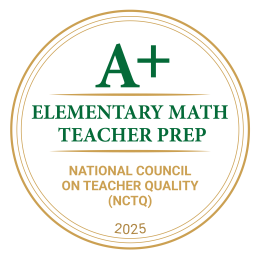 Students are eager to share news of getting a good grade in school. Wright State University is no different: The university recently received an A+ for elementary math teacher preparation from the National Council on Teacher Quality.
Students are eager to share news of getting a good grade in school. Wright State University is no different: The university recently received an A+ for elementary math teacher preparation from the National Council on Teacher Quality.
Faculty in Wright State’s elementary education P–5 program are proud of the accomplishment, not only for the program, but also for its students and the Dayton region, where many alumni teach the adults of tomorrow.
“Wright State’s undergraduate program is among the best in the nation for devoting sufficient time to math,” said Ron Noble, chief of teacher prep for the National Council on Teacher Quality, a nonprofit organization that researches, evaluates and provides guidance on teacher preparation.
To Dave Herick, instructor of teacher education and program director for elementary education in Wright State’s College of Health, Education and Human Services, that assessment adds up.
“The national council looks at your program, course offerings and content — in this case math,” he said. “They make sure you’re covering the areas of math content and, in addition, measure if your program is effectively teaching the pedagogy how to effectively instruct mathematics. They look carefully at how deeply you cover each area.”
Herick said the top grade is significant for a couple of reasons.
“One, students can choose any university to study teacher education,” he said. “They’re looking for programs that are accredited with a rating at the highest levels to be sure they’re getting the best training.”
“Another reason is that it sends a message to future employers that Wright State has a high-quality program in teacher education and our candidates graduate well-prepared to bring the wonder, power and beauty of mathematics to student,” said Herick, who earned a bachelor’s degree in political science, his teacher certification and a master’s degree in principalship and educational leadership at Wright State.
Training future teachers to teach math is one aspect of Wright State’s Elementary Education P-5 program. Nationally there is a major focus on how students learn and perform in math and on how universities prepare teachers to teach the subject.
“Education and elementary education is one of the biggest majors by number at Wright State,” said Colleen Saxen, Ed.D., associate professor and chair of the Department of Teacher Education. She earned a master’s degree in public health education and a doctorate in organizational studies from Wright State.
Wright State admits a new group of 60 to 70 elementary education P–5 students each spring during their junior year. These students have either completed prerequisite courses at Wright State or transferred from other institutions. Once admitted, students complete three semesters of coursework in the program before graduation. At any given time, approximately 130 students are enrolled in the program in their third and fourth years at Wright State.
Each incoming group selects five or six student leaders who serve as liaisons between their classmates and the department faculty. These leaders collect feedback and concerns from fellow students and communicate them directly to professors and administrators. They also plan community building events and professional development, which further strengthens the program’s quality and impact.
“It’s a constructive and positive way to solve problems and build community,” Saxen said. “The relationships students build with each other, faculty and community partners are one of the strongest aspects of our programs. Our student leaders are integral in these endeavors.”
Saxen expressed pride in all of Wright State’s teacher preparation programs, particularly praising Herick’s leadership in fostering a strong sense of community among students and faculty.
The program also strengthens the broader Dayton region, as many Wright State graduates go on to work as teachers, principals and administrators in local schools.
“Wright State has a very strong anchor in local school districts,” she said. “It’s gratifying to those of us in higher ed that in a class of 30 elementary education majors, each will have a class of 30 students one day. That’s an incredible ripple effect.”
She added, “Whatever career young children are going into, a lot of them are interfacing with teachers who graduated from Wright State. That’s a tremendous boon to our entire region.”

 Wright State Police Department delivers major donation to Raider Food Pantry
Wright State Police Department delivers major donation to Raider Food Pantry  Wright State engineering and computer science students earn prestigious federal SMART Scholarships
Wright State engineering and computer science students earn prestigious federal SMART Scholarships  Wright State Police Chief Kurt Holden selected for prestigious FBI National Academy program
Wright State Police Chief Kurt Holden selected for prestigious FBI National Academy program  Wright State’s Raj Soin College of Business ranked among the best for entrepreneurs by Princeton Review
Wright State’s Raj Soin College of Business ranked among the best for entrepreneurs by Princeton Review  Wright State’s annual Raidersgiving draws hundreds
Wright State’s annual Raidersgiving draws hundreds 